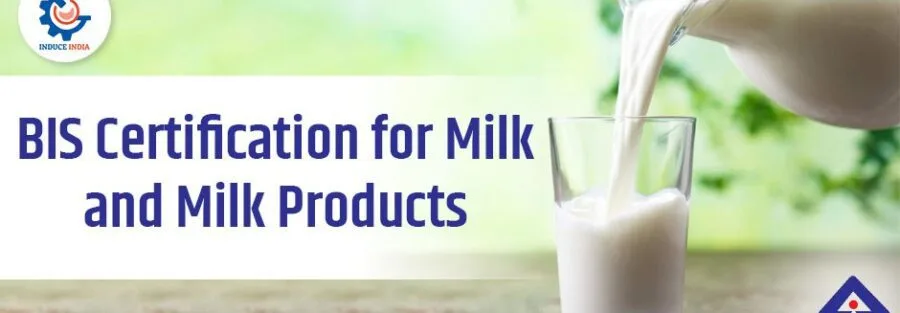BIS Certification for Milk and Milk Products is a crucial process that ensures the quality and safety of these products for consumption. The Bureau of Indian Standards (BIS) is the national standards body of India, and it is responsible for setting and maintaining standards for various products, including milk and milk products.
In this article, we will discuss the importance of BIS certification for milk and milk products, the process of obtaining BIS certification, and the benefits of being BIS certified.
Milk and milk products are an essential part of our diet, and it is essential to ensure that they are safe and of high quality for consumption.
BIS certification ensures that the milk and milk products have been manufactured and packaged by the Indian standards set by the BIS. These standards cover various aspects such as hygiene, quality, and safety of the products, which are essential for the health and well-being of the consumers.
BIS Certification Process For Milk Products
The Indian standards for milk and milk products cover a wide range of products, including milk, curd, butter, ghee, cheese, and ice cream. These standards specify the requirements for the composition, quality, and labeling of these products. For example, the standards for milk specify the minimum and maximum levels of fat, protein, and SNF (solids not fat), and the standards for ghee specify the minimum levels of fat and moisture.
Familiarization with BIS Standards and Requirements for Milk and Milk Products
Familiarization with BIS standards and requirements for milk and milk products is the first step in the process of obtaining BIS certification. This involves understanding the specific standards that apply to the production, packaging, and labeling of milk and milk products in India.
The BIS has established standards for various aspects of the milk industry, including raw milk quality, pasteurization and sterilization, composition and labeling of milk products, packaging and storage requirements, and microbiology and hygiene standards for milk production.
Familiarizing oneself with these standards will help ensure that the production facility and processes are compliant and that the products meet the required standards.
Preparation of a Self-Declaration or Application for Certification
Preparation of a self-declaration or application for certification is the second step in the process of obtaining BIS certification for milk and milk products.
A self-declaration or application is a document that is submitted to a BIS-approved certification body, containing information about the facility and its production processes, including details of the products being manufactured and the BIS standards that are being followed.
The self-declaration or application is usually a detailed document that includes information such as the facility’s name and address, details of the products being produced, the names and qualifications of key personnel, and a description of the production processes and equipment used. It will also include a declaration that the facility and products comply with the relevant BIS standards.
The self-declaration or application must be accurate and complete, as it forms the basis for the initial assessment or pre-audit and the certification audit.
Once the self-declaration or application is submitted, it will be reviewed by the certification body to ensure that it meets the requirements for certification.
Initial Assessment or Pre-audit of The Facility and Production Process
Implementation of corrective actions or improvements is the fifth step in the process of obtaining BIS certification for milk and milk products. It’s a process of addressing any non-conformities or areas for improvement that were identified during the initial assessment, pre-audit, or certification audit.
Corrective actions are steps taken to eliminate the cause of a detected non-conformity and to prevent a recurrence. Improvements, on the other hand, are actions taken to enhance the existing management system or production process.
After the initial assessment, pre-audit, or certification audit, the facility will be provided with a report indicating any non-conformities or areas for improvement.
The facility must then implement corrective actions or improvements to address these issues before the next audit. The certification body will verify the effectiveness of the implemented corrective actions or improvements during the next surveillance audit.
The facility must implement the corrective actions and improvements promptly and keep records of the actions taken and their effectiveness. This is important for maintaining the certification and ensuring that the facility and production process continue to meet the relevant BIS standards.
Obtaining the BIS Certification Certificate
Obtaining the BIS certificate is the sixth step in the process of obtaining BIS certification for milk and milk products. This certificate is issued by a BIS-approved certification body and serves as formal recognition that the facility and its production process comply with the relevant BIS standards.
The certification certificate is issued once the facility has completed the initial assessment or pre-audit, the certification audit, and any necessary corrective actions or improvements.
The certificate is issued in the name of the facility and is valid for a specified period, typically three years.
The certification will include information such as the facility’s name and address, the scope of the certification (e.g. specific milk products or production processes), and the BIS standards to which the facility is certified. The certificate will also include the date of issue and the expiration date of the certification.
It is important to note that to retain the certification, the facility will need to undergo regular surveillance audits to ensure continued compliance with the BIS standards.
Affixing the BIS Standard Mark on the Product
Once a facility has obtained BIS certification for milk products and milk, it is required to affix the BIS standard mark on the products.
The BIS standard mark is a symbol that indicates that the product has been certified by BIS and meets the relevant Indian standards.
The standard mark should be affixed on the product, packaging, or labeling in a way that is visible and legible.
Ongoing Compliance Monitoring and Surveillance Audits
Maintaining BIS standards for milk and milk products requires ongoing compliance monitoring and surveillance audits. These audits are conducted by the BIS-approved certification body to ensure that the facility and its production process continue to meet the relevant BIS standards. Surveillance audits are typically conducted on an annual basis, or more frequently if deemed necessary.
Any non-conformities or areas for improvement identified during the surveillance audit must be addressed by the facility before the next audit.
Maintaining Records of Testing and Inspection
Maintaining records of testing and inspection is an important aspect of BIS standards for Milk and Milk Products. The facility must keep accurate and up-to-date records of all testing and inspections, including the results of raw milk quality tests, product composition, and labeling tests, packaging and storage tests, and microbiology and hygiene tests.
These records must be made available to the BIS-approved certification body during audits and inspections.
The facility must have records of all testing and inspection done, as these are required for maintaining the certification.
Conclusion
In conclusion, BIS certification for milk and milk products is a process that ensures that the facility and its production process comply with the relevant Indian standards established by the Bureau of Indian Standards (BIS).
The process includes familiarizing oneself with BIS standards and requirements, preparing a self-declaration or application for certification, undergoing an initial assessment or pre-audit, a formal certification audit, implementing corrective actions or improvements, obtaining the BIS certification certificate, affixing the BIS standard mark on the product, ongoing compliance monitoring, and surveillance audits, and maintaining records of testing and inspection.
Obtaining and maintaining BIS certification is important for ensuring the quality and safety of milk and milk products, and it also helps to establish credibility and trust with customers and stakeholders.



